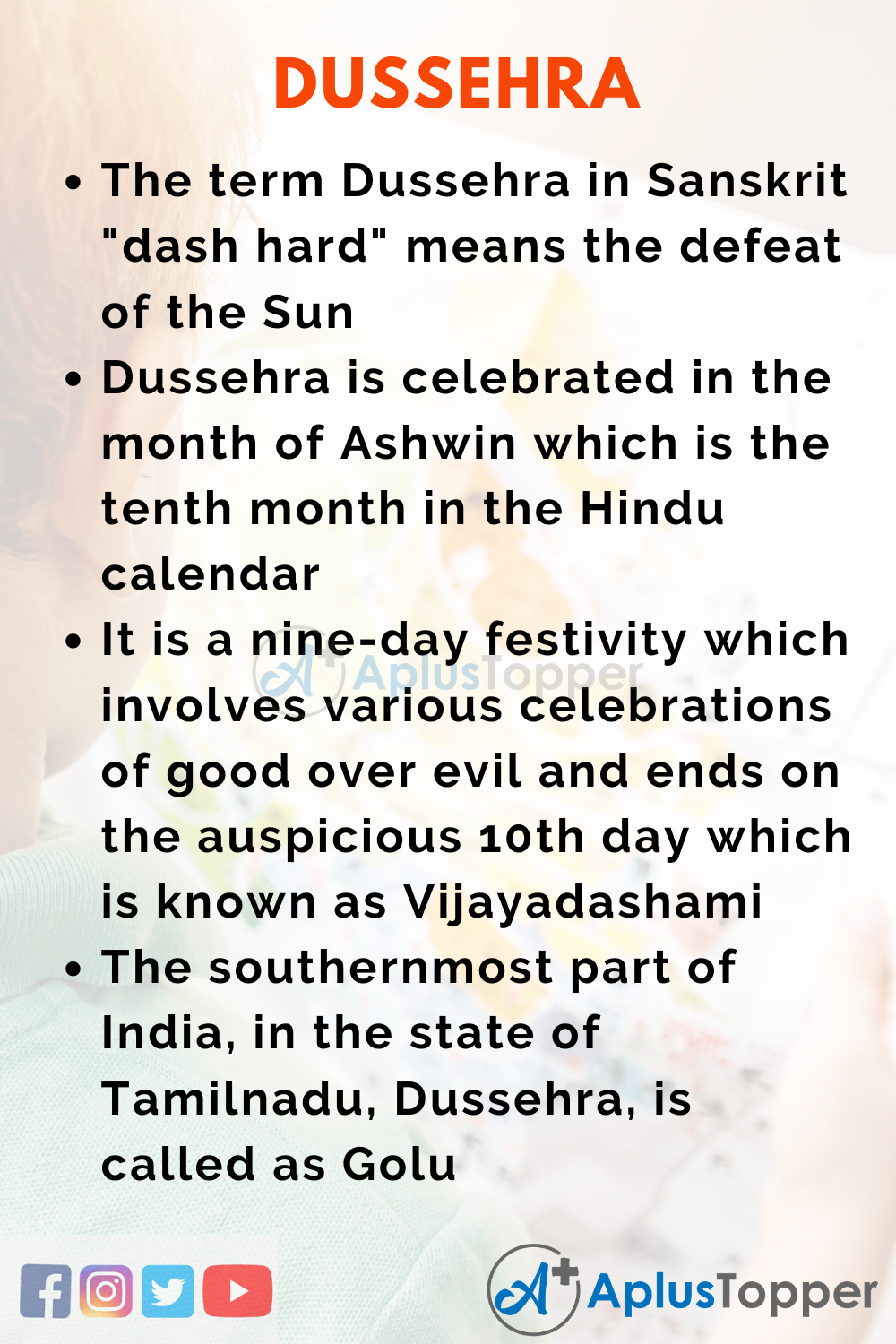10 Lines on Dussehra: Dussehra is a popular Hindu festival that is also known as Vijayadashami that celebrates the victory of good over evil. Dussehra is one of the longest festivals in the Hindu traditions which is celebrated for 10 days, starting with 9 Nights which is known as Navratri and the last day is called as Vijayadashami, which has a lot of significance in the Indian traditions.
Dussehra is the day when the Chamundeshwari Durga, an Indian goddess, kills the Asura demon, Mahishasura. This festival also marks the victory of Ram, one of the Avatar of Vishnu, over the Killing of the 10 headed Ravana, in the great Indian epic of Ramayana.
You can read more 10 Lines about articles, events, people, sports, technology many more.
Set 1 – 10 Lines on Dussehra for Kids
Set 1 is helpful for students of Classes 1, 2, 3, 4 and 5.
- Dasara is the most popular Hindu festival which is celebrated for 10 days
- Dussehra signifies the victory of Lord Ram over the demon Ravana in the Indian epic of Ramayana
- It is one of the festivals that celebrate the victory of good over evil in Hindu religion
- Dussehra also is known as Navratri celebration is celebrated across Indian households to spread happiness, joy and triumph
- The values of Dussehra is not just followed by Hindus but also other religions in the country such as Muslim,s Christians and Sikhs
- The term Dussehra in Sanskrit means getting rid of 10 Evils
- Ram-Leela is an act of Ramayana that is usually performed on the day of Vijayadashami
- The effigies of demons such as Ravan, Kumbhkaran and Meghnath are burnt on this day
- Fireworks take place to burn the ten-headed Ravana and it is the big spectacle on the day of Vijayadashami
- Dussehra marks the end of the barbaric role of the king of Lanka Ravana in the Indian subcontinent.

Set 2 – 10 Lines on Dussehra for School Students
Set 2 is helpful for students of Classes 6, 7 and 8.
- When Lord Ram fires the arrow that killed Ravana in the battlefield of Lanka, there was a huge victory of good over evil in the Indian subcontinent
- Dasara marks the victory of Lor Ram over Ravan and the victory of good over evil
- It is on this day that Lord Ram met his wife Sita after being kidnapped by the evil king of Lanka
- Mysore Dasara which is a huge celebration in the southern state of Karnataka follows a few different traditions than the rest of the country
- Grand elephant procession in the streets of Mysore marks the beginning of Dussehra in the Southern parts of the country
- In the south part of India, people believe that goddess Chamundeshwari killed Mahishasura on the day of Vijayadashami
- The Dussehra festival in the south began as early as in the 15 Century by the Vijayanagara empire
- The traditions of Dussehra procession is carried out till date by the Wodeyar your family of the Mysore Palace
- Usually, the nine days of Navratri is considered to be very pure and non-vegetarian food and onion and garlic are not consumed by any of the Hindus in the country
- Ravan might be an evil king, but he is worshipped in 6 parts of India, namely Mandasur, Bisrakh, Gadichiroli, Kangra, Mandya and Kolar because he was considered as a great fighter and a devout Brahmin.
Students can also find Paragraph on Dussehra and Dussehra Essay from here.
Set 3 – 10 Lines on Dussehra for Higher Class Students
Set 3 is helpful for students of Classes 9, 10, 11, 12 and Competitive Exams.
- The term Dussehra in Sanskrit “dash hard” means the defeat of the Sun
- Dussehra is celebrated in the month of Ashwin which is the tenth month in the Hindu calendar
- It is a nine-day festivity which involves various celebrations of good over evil and ends on the auspicious 10th day which is known as Vijayadashami
- The festival is observed by putting Tika over the forehead, special prayers to God, religious rituals and burning of effigies of Ravan, Kumbhkaran and Meghnad
- Mahishasura is the king of the asuras and he tortured the Dewas
- In the southern part of the country, goddess Chamundeshwari kills the Asura King, Mahishasura, and hence she is known as Mahishasura Mardini
- The southernmost part of India, in the state of Tamilnadu, Dussehra, is called as Golu
- According to mythology, Goddess Durga obtained her power from all other Gods and Goddesses who stood as statues around her when she killed Mahishasura on the day of Viajadashami
- In Northern parts of the country, Dussehra is celebrated by sowing barley seeds on the first day of Navratri
- Certain people believe that Goddess Durga and her children Lakshmi, Ganesha, Kartik and Saraswati returned to Lord Shiva on the day of Dussehra

FAQ’s on 10 Lines on Dussehra in English
Question 1.
Other than India, in which countries is Dussehra celebrated?
Answer:
Dussehra is celebrated in Bangladesh, Nepal and Malaysia and all other countries where there is a significant Hindu population
Question 2.
Why does Dussehra hold importance to farmers of India?
Answer:
Dashara holds importance to the agricultural community of India because it is the harvesting season for Kharif crops and sowing of Rabi crops
Question 3.
What is the significance of Dussehra?
Answer:
Dashara signifies the victory of good over evil and it is on this day that Lord Ram defeated the evil king of Lanka Ravana and freed his wife Sita and the people of the Indian subcontinent
Question 4.
What is the most important tradition during Dussehra celebrations?
Answer:
The most important tradition in Dussehra celebration is the burning of the effigy of Ravan
